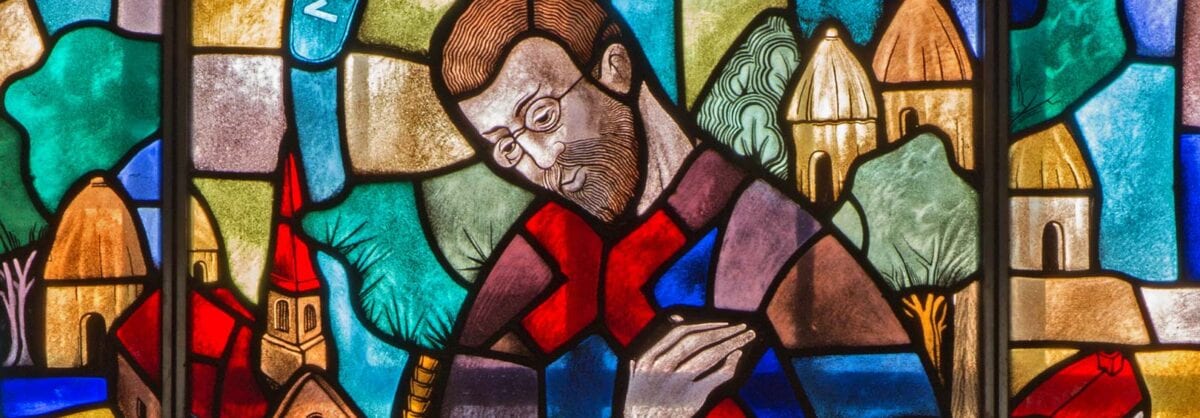This reflection was previously published.
Right now two friends of friends have cancer. I routinely find myself drawn into conversations that are held in corners of rooms and spoken in hushed tones. The talk revolves around the numbers: what stage, what percent survival at how many years. I stay focused on the “facts,” unwilling, I admit, to address the real fear that takes hold of my heart: What will happen when death comes for me?
In the saints, I see another way. Where I am cowering, they are taking courage. When I am speaking in worried whispers, their voices are announcing with wonder, “I have seen the Lord!” (John 20:18). Mary Magdalene’s cry, it seems to me, is the primary fact of a saint’s life. Christ is alive—he has bested sin and death. And the acceptance of this fact has changed everything.
I follow the saints because I want this fact to overtake my own life.
Our beloved Saint Elizabeth Ann Seton lived with this Easter certainty. When her husband William was dying from tuberculosis, she made the agonizing decision to leave her littlest children at home—including her new baby—and take William on the arduous journey to Italy, hoping its milder climate might renew his health. Others trembled at the peril such a voyage might bring upon William, and upon Elizabeth and their oldest daughter traveling with them. But she was adamant: “You know that I go fearless,” she wrote, “all is well and resting on the mercy of God.”
The saint we celebrate on May 10, Damien de Veuster, had the same verve. An internet search yields two telling photos of Damien. In one, he is a young, broad-shouldered, farm-boy-turned-missionary. In the other, he is older and portly. Beneath a wide-brimmed hat, his face is swollen and disfigured by the leprosy that would go on to take his life. That strapping young man left his native Belgium and spent his life among the lepers of Hawaii. He lived and died, fearless.
Damien had already been several years in Hawaii, when the authorities, in an effort to contain the spread of the contagion, began to ship the lepers to the remote peninsula of Molokai. Each leper was ripped from his or her family and community. Each man, woman, and child suffered some stage of the disfiguring and debilitating illness with no hope of cure. In the remote and inaccessible Molokai, with only the bare necessities of life, the lepers’ sorrow soon gave way to despair. Refuse piled up. Dead bodies lay unburied. Drunkenness and debauchery were rife.
When the Hawaiian bishop asked his priests for a volunteer to live among these abandoned souls, Damien came forward first. On May 10, 1873, he landed on Molokai to serve the 800 residents. He began by addressing their basic needs –the essentials. He bandaged wounds. He buried the dead. He flexed his farm boy muscles in a thousand tasks: rebuilding huts, planting trees, digging gardens, building a system to carry water. He taught them songs and organized a school.
Early on, Damien chose to ignore all the words of caution about proper hygiene. He washed the bodies of the lepers, dipped his food in the same dish with them, placed communion on their tongues. Long before he contracted leprosy himself, he began his homilies with the words, “We lepers…”—such was his willingness to identify with those he served.
Slowly, but certainly, led by this one man, the miserable heap of a colony grew into an ordered village, with neat rows of houses, gardens and singing. His efforts unleashed a wave of compassion. Government leaders acclaimed him, and religious leaders vied to join him. His compassion and his courage were lauded by many.
But Damien was keenly aware that no sheer force of will could keep a man among such misery. No human being can persevere in the face of wretchedness on principle alone. What anchored Damien’s existence was a living reality: Christ present here and now.
Like Elizabeth Ann Seton, who yearned for the Body of the Lord while she sat yet in the pew of an Episcopal church, Damien found in the Eucharist his source and center. He built an adoration chapel and spent hours himself before the Blessed Sacrament. “Without the continuous presence of our Divine Master in my poor chapel,” he wrote, “I would not have been able to persevere in my resolve to share the lepers’ fate.”
He taught the lepers to pray with him before the Blessed Sacrament, to offer their sufferings in union with his Sacred Heart. And thus their deaths, united to that of Christ, began to speak of the Resurrection. “The cemetery and huts of the dying,” he confessed, “are my most beautiful books of meditation.” And so, in the end, when Damien discovered in his own flesh the telltale signs of the disease, he could rejoice: “There is no longer any doubt about it—I am a leper. Praised be the Good Lord!” Death came three years later. Though ravaged by the disease, Damien was at peace and died with a smile on his face.
In St. Damien and St. Elizabeth Ann and all those who live with Easter certainty, I see an answer to my fear. In the face of death, they turn to the living God, who lives among us still in the Eucharist, in the Church, and in the lives of others who have been transformed by him. The saints yield themselves to Christ, letting him conquer death again in their own flesh. In their company, I find the strength to go forward.
LISA LICKONA, STL, is Assistant Professor of Systematic Theology at Saint Bernard’s School of Theology and Ministry in Rochester, New York, and a nationally-known speaker and writer. She is the mother of eight children.
Image: St. Damien de Veuster among the lepers, stained glass, St. Anthony’s church, Leuven, Belgium.
To view all of our Seton Reflections, click here.
